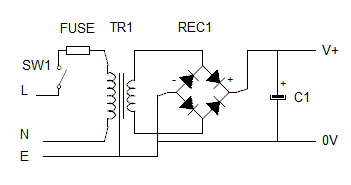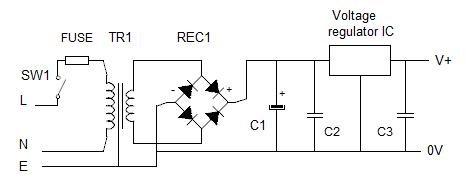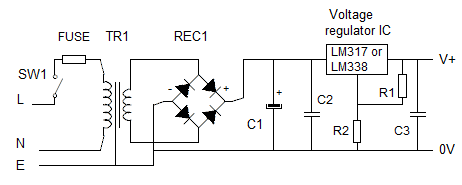John Errington's tutorial on Power Supply Design
Rules of Thumb and example designs
1: Smoothed unregulated supply.
 For an output of Vout volts DC at Iout amps max you need the following (minimum values):
For an output of Vout volts DC at Iout amps max you need the following (minimum values):
Transformer: Mains : Vrms rated at Vout volts, Vout*Iout*1.25 watts.
Bridge Rectifier: rated 3 * Vout at around 2 * Iout
Capacitor: 5000uF * Iout at 1.5 * Vout
Example: Design a simple capacitor smoothed DC supply to operate from 240V mains and provide 24V at 2A.
Transformer: 240:24V RMS rated 24*2*1.25 = 60VA
Rectifier: 3 * 24 = 76V @ 2 * 2 = 4A (get 100V 5A)
Capacitor: 5000*2 = 10,000uF at 24*1.5 = 36V
2: Simple regulated supply
 We can add a commercial regulator IC to the circuit above but will need to increase some values, to provide for the "drop out voltage" needed for the regulator to operate. This is typically 3V.
We can add a commercial regulator IC to the circuit above but will need to increase some values, to provide for the "drop out voltage" needed for the regulator to operate. This is typically 3V.
Transformer: Mains : Vrms rated at (Vout +3) volts, (Vout+3)*Iout*1.25 watts.
Bridge Rectifier: rated 3 * Vout at around 2 * Iout
Capacitor: 5000uF * Iout at 1.5 * Vout
The 78XX series regulators are inexpensive and can provide voltages of 5,6,8,9,10,12, 15,18 & 24 Volts at 1A.
For higher currents (or different voltages) the LM338 regulators can provide up to 5A when mounted on a suitable heat sink.
For more precision, or better flexibility, use one of the designs shown earler.
Example: Design a simple regulated DC supply to operate from 240V mains and provide 18V at 4A.

Transformer: 240:21V RMS rated 21*4*1.25 = 105VA (24V 120VA)
Rectifier: 3 * 21 = 63V @ 4 * 2 = 8A (get 63V 8A )
Capacitor: 5000*4 = 20,000uF at 21*1.5 = 26V
Regulator: LM338 with heat sink
R1: 1k2 R2: 16k
